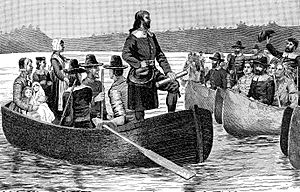Colony of Rhode Island and Providence Plantations facts for kids
Quick facts for kids
Colony of Rhode Island and Providence Plantations
|
|||||||||
|---|---|---|---|---|---|---|---|---|---|
| 1636–1776 | |||||||||
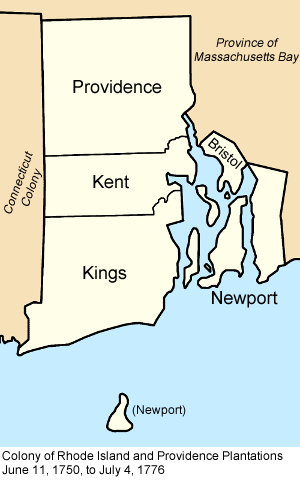 |
|||||||||
| Status | Colony of England (1636–1707) Colony of Great Britain (1707–1776) |
||||||||
| Capital | Providence, Newport | ||||||||
| Languages | English, Narragansett, Massachusett | ||||||||
| Ethnic groups | English, Black, Narragansett, Wampanoag, Niantic | ||||||||
| Government | Crown Colony | ||||||||
| Governor | |||||||||
| History | |||||||||
|
• Established
|
1636 | ||||||||
|
• Foundation
|
1637 | ||||||||
|
• Chartered as an English colony
|
1644 | ||||||||
|
• Coddington Commission
|
1651–1653 | ||||||||
|
• Royal Charter
|
1663 | ||||||||
|
• Part of the Dominion of New England
|
1686–1688 | ||||||||
|
• Resumption of Royal Charter
|
1688 | ||||||||
|
• Disestablished
|
1776 | ||||||||
| Currency | Rhode Island pound | ||||||||
|
|||||||||
| Today part of | United States | ||||||||
The Colony of Rhode Island and Providence Plantations was one of the first Thirteen Colonies in America. It was on the east coast, next to the Atlantic Ocean. Roger Williams started it in 1636. It was an English colony from 1636 to 1707. After that, it became a colony of Great Britain until 1776. That's when the American Revolution happened, and it became the State of Rhode Island.
Contents
How Rhode Island Began
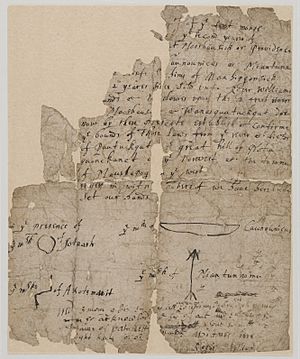
Before Europeans arrived, the land was home to the Narragansett Indians. This is why a modern town is called Narragansett, Rhode Island. Europeans started settling around 1622. They set up a trading post in a place now called Warren, Rhode Island.
Roger Williams was a Puritan religious leader. He founded Providence Plantations in 1636. The Narragansett chief Canonicus gave him the land. Williams had been forced to leave the Massachusetts Bay Colony. This was because of his religious beliefs. He and his group agreed on a fair system of government. It allowed people to have freedom of religion. Williams named the settlement Providence Plantation. He believed God had led them there. A "plantation" in the 1600s meant a farming colony. Williams named nearby islands after good qualities: Patience, Prudence, and Hope.
In 1637, another group from Massachusetts bought land. They bought it from the Indians on Aquidneck Island. This island was also called Rhode Island back then. They started a settlement called Pocasset. This group included William Coddington and Anne Hutchinson. But the settlement soon split into two. Samuel Gorton stayed and started Portsmouth in 1638. Coddington and John Clarke started Newport in 1639. Both of these towns were on Aquidneck Island.
Another settlement on the mainland was Shawomet. Samuel Gorton bought this land from the Narragansetts in 1642. Soon after, Massachusetts claimed this land. Gorton went to London for help. He got a letter from Robert Rich, a powerful English leader. This letter told Massachusetts to leave Gorton alone. In thanks, Gorton changed Shawomet's name to Warwick in 1648.
A Place for Religious Freedom
After England's king was restored in 1660, Rhode Island needed a new Royal Charter. King Charles II gave them one in 1663. He liked that the colony promised religious freedom. This charter joined the four settlements into one colony. It was called the Colony of Rhode Island and Providence Plantations. Many groups who were treated unfairly settled there. These included Quakers and Jews.
Rhode Island was very advanced for its time. It passed laws against witchcraft trials. It also stopped jailing people for debt. Most serious crimes no longer led to the death penalty. The colony even passed America's first anti-slavery law in 1652. However, slavery still happened in Rhode Island. There is no proof this law was ever fully enforced.
Rhode Island usually got along with local Native American tribes. But other New England colonies had problems with tribes. This sometimes led to fighting. Rhode Island leaders tried to make peace. During King Philip's War (1675–1676), both sides ignored Rhode Island's neutrality. The biggest battle was in Rhode Island. It happened on December 19, 1675. Soldiers from Massachusetts, Connecticut, and Plymouth attacked. They destroyed a Narragansett village in the Great Swamp. The Narragansetts also attacked and burned towns in Rhode Island. This included Providence. Roger Williams knew the Native American leaders Metacom (King Philip) and Canonchet. He told the Massachusetts Governor about enemy movements. Providence Plantations tried to protect itself. Williams even trained people for defense. King Philip was killed in Mount Hope, Rhode Island. This was one of the last actions of the war.
Changes in Government
In the 1680s, King Charles II wanted more control over the colonies. He wanted to manage their trade better. The Navigation Acts were laws about trade. Many colonists disliked them. Colonial governments, especially Massachusetts, did not enforce these laws. King James II created the Dominion of New England in 1686. This was to gain more control. Rhode Island became part of this Dominion. Sir Edmund Andros was the governor. His rule was very unpopular.
In 1688, the "Glorious Revolution" happened in England. King James II was removed from power. William III and Mary II became the new rulers. In April 1689, Massachusetts leaders had Andros arrested. He was sent back to England. The Dominion ended, and Rhode Island went back to its old government.
The colony's economy relied on farming, especially dairy. Fishing was also very important. Lumber and shipbuilding grew into big industries. Slaves were brought to the colony. Even though there was an old law against slavery, it was not followed. Rhode Island later became rich from the slave trade. They made rum to sell in Africa. This was part of a profitable triangular trade system. It involved slaves and sugar between Africa, America, and the Caribbean.
Rhode Island and the American Revolution
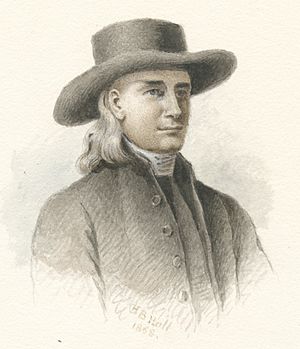
Important people from Rhode Island helped start the American Revolutionary War in 1776. This war led to American independence from the British Empire. These leaders included former governors Stephen Hopkins and Samuel Ward. Others were John Brown and Nicholas Brown. They also helped found Brown University in Providence in 1764. This university was a place for religious and intellectual freedom.
On May 4, 1776, Rhode Island was the first of the 13 colonies to declare independence. It was the fourth to approve the Articles of Confederation in 1778. This was an agreement between the new states. Rhode Island did not send representatives to the 1787 convention. This meeting created the United States Constitution. Rhode Island also refused to ratify it at first.
However, it changed its mind after Congress sent a series of amendments. These amendments were called the United States Bill of Rights. They protected personal freedoms and rights. They also limited the government's power. On May 29, 1790, Rhode Island became the 13th state. It was the last of the original colonies to ratify the Constitution.
Changing Borders
The colony's borders changed many times. There were often arguments with Massachusetts and Connecticut. These colonies also claimed some of Rhode Island's land. Early agreements for Rhode Island did not set the eastern border. They also did not include Washington County. This land belonged to the Narragansett people. The first settlements were Providence, Warwick, Newport, and Portsmouth. The colony grew by buying land from the Narragansetts. This land stretched west toward Connecticut. Smaller islands in Narragansett Bay were also added. Block Island was settled in 1637. It became part of the colony in 1664. It was named New Shoreham in 1672.
Western Border with Connecticut
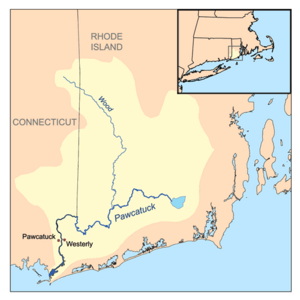
Connecticut's charter vaguely described its western border. It mentioned the "Narragansett River." In 1663, leaders decided this meant the Pawcatuck River. The border followed this river from its mouth to the Ashaway River mouth. From there, a line went north to the Massachusetts line. This settled a long dispute. Connecticut and Massachusetts also claimed these former Narragansett lands. The dispute continued until 1703, when the decision was upheld. After many surveys, a clear line was set in 1728.
Eastern Border with Massachusetts
The eastern border with Massachusetts was also disputed. Both Plymouth and Rhode Island had charters. These charters gave them land three miles inland east of Narragansett Bay. In 1741, this area was given to Rhode Island. This meant Rhode Island gained control of Barrington, Warren, Bristol, Tiverton, and Little Compton. Massachusetts had claimed these towns. The 1741 decision also gave most of Cumberland to Rhode Island. The final borders north of Barrington were set much later. This happened almost a century after American independence. It took many court cases. In 1862, a part of Tiverton went to Massachusetts. It became part of Fall River. Two-thirds of Seekonk (now eastern Pawtucket and East Providence) went to Rhode Island.
Northern Border with Massachusetts
Rhode Island's northern border with Massachusetts also changed. Massachusetts surveyed this line in 1642. But later surveys by all three colonies showed it was too far south. In 1718-19, Rhode Island and Massachusetts agreed on roughly that line. The part east of the Blackstone River was still argued about until 1741. This is where the border remains today.
Population Growth
| Historical population | ||
|---|---|---|
| Year | Pop. | ±% |
| 1640 | 300 | — |
| 1650 | 785 | +161.7% |
| 1660 | 1,539 | +96.1% |
| 1670 | 2,155 | +40.0% |
| 1680 | 3,017 | +40.0% |
| 1690 | 4,224 | +40.0% |
| 1700 | 5,894 | +39.5% |
| 1710 | 7,573 | +28.5% |
| 1720 | 11,680 | +54.2% |
| 1730 | 16,950 | +45.1% |
| 1740 | 25,255 | +49.0% |
| 1750 | 33,226 | +31.6% |
| 1760 | 45,471 | +36.9% |
| 1770 | 58,196 | +28.0% |
| 1774 | 59,607 | +2.4% |
| 1780 | 52,946 | −11.2% |
| Sources: 1640–1760; 1774 1770–1780 | ||
From 1640 to 1774, Rhode Island's population grew a lot. It went from 300 people to 59,607. But during the American Revolutionary War, it dropped to 52,946 in 1780. After William Coddington and others bought Aquidneck Island in 1639, Newport, Rhode Island grew fast. Its population went from 96 in 1640 to 7,500 in 1760. This made Newport the fifth-largest city in the Thirteen Colonies. By 1774, Newport had 9,209 people.
The black population also grew. It went from 25 in 1650 to 3,668 in 1774. This was about 3 to 10 percent of the total population. Like the rest of the state, it dropped to 2,671 by 1780. In 1774, Indians made up 1,479 people. This was about 3 percent of the colony's population.
Rhode Island was the only New England colony without an official church. In 1650, there were only 4 places of worship in Rhode Island. These included 2 Baptist and 2 Congregational churches. By 1658, a small Jewish community lived in Newport. After a religious movement called the First Great Awakening (1730–1755), the number of churches grew. By 1750, Rhode Island had 50 places of worship. These included 30 Baptist, 12 Congregational, and 7 Anglican churches, plus 1 Jewish synagogue.
Many Puritans moved to New England between 1629 and 1642. This was after King Charles I of England issued a charter for the Massachusetts Bay Colony. After the English Civil War ended in 1651, fewer people moved to New England. Most of the population growth then came from families having children. It was not from new immigrants or slave imports.
Unlike other colonies, most Puritan immigrants came as families. About two-thirds of the men were married. By the American Revolution, only 2 percent of New England's workers were forced laborers. Another 2 percent were black slaves. Also, 9 percent of the black population in New England were free. In 1784, Rhode Island passed a law to slowly end slavery. By 1790, 78 percent of the black population in Rhode Island was free. Slavery was completely ended in Rhode Island by 1842.
See also
 In Spanish: Colonia de Rhode Island y las Plantaciones de Providence para niños
In Spanish: Colonia de Rhode Island y las Plantaciones de Providence para niños




